|
CARDIAC SURGERIES
General medical information
Hungary is renowned all over the world for its very high niveau of medical education, high medical standards and advanced medical procedures.
|
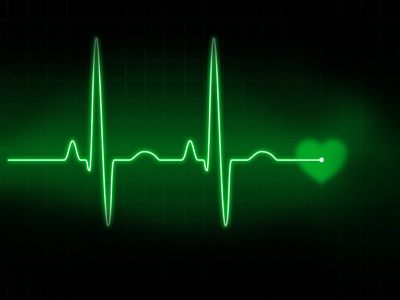
|
Thousands of international students from all over the world ( from Arabic / African states, Scandinavia, etc. ) have been
studying at Hungarian universities ( Budapest / Szeged / Debrecen / Pecs ) because of the high level of education.
Hungarian hospitals work with state-of-the-art medical technologies and there are no bacterial infections ( unlike many hospitals in the UK: many have MRSA ).
And there are no waiting lists.
HOW TO PLAN YOUR TREATMENT...
It is so simple with us:
1. Contact your local agent
2. Book your treatment
3. Book your flight ( time period depends on what you intend to do - discuss the options with your local agent )
4. Consultation and treatment
5. Clinical stay with Rehabilitation ( 7 days ) - stitch removal during extra rehabilitation
6. Extra Rehabilitation: up to 2 weeks ( highly recommended )
7. Travelling back home
|
CARDIAC SURGERIES
In our very stressing world there are more and more people suffering from heart problems ( each day plenty of new diagnosed patients all over Europe ): the most dangerous one after cancer.
There are more patients waiting for surgeries than can be treated.
If the desease is not realised and cured in time, it can be just too late...
Because of very high healthcare prices of some countries, many people are just forced to go to other countries for much cheaper medical treatments in order to save as much as 70%, compared to Western European ( or American ) prices and also avoiding the long waiting lists.
|

|
Your travel & treatment Your doctors & Locations Prices & costs
The following procedures / surgeries are available ( no waiting list ):
1. Cardiac catheterisation
2. Coronary angioplasty with stent(s)
3. Coronary artery bypass
4. Heart valve replacement
5. Ablation
6. Cardioverter defibrillator implantation
7. Pacemaker implantation
8. Combined Angioplasty / Bypass / Valve replacement
9. Correction of congenital heart malformations
|
Cardiac catheterisation
Cardiac catheterization ( or coronary angiogram ) is an invasive imaging procedure that tests for heart disease by allowing your doctor to "see" how well your heart is functioning. During the test, a long and narrow tube, called a catheter, is inserted into a blood vessel in your arm or leg and guided to your heart with the aid of a special X-ray machine.
This procedure is the first step before a cardiac operation because this gives an exact picture of your heart and arteries. For example, the doctor put a special dye in the catheter. This dye will flow through the bloodstream to the heart. Once the dye reaches the heart, it will make the inside of the coronary ( heart ) arteries show up on an x-ray ( this is called coronary angiography ). The dye can show whether a substance called plaque has narrowed or blocked any of the coronary arteries. Plaque is made up of fat, cholesterol, calcium, and other substances found in blood. Plaque narrows the inside of the arteries and, in time, may restrict blood flow to the heart.
When plaque builds up in the coronary arteries, the condition is called coronary heart disease ( or coronary artery disease ).
Patients are awake during the procedure, and it causes little to no pain. However, you may feel some soreness in the blood vessel where the catheter was inserted.
Cardiac catheterisation causes no serious complications.
|
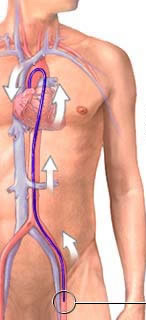
|
|
Coronary angioplasty with stent(s)
Angioplasty improves blood flow to the heart to reduce the chances of a heart attack.
During angioplasty and stenting, a long hollow tube called a catheter is inserted in the femoral artery in the groin area. The catheter is then maneuvered through the arteries until it reaches the narrowing in the carotid artery in the neck. An umbrella-shaped filter is inserted beyond the narrowing to catch any plaque or debris that may break off during the procedure. Then, a tiny balloon at the end of the catheter is inflated to push the plaque to the side and widen the vessel. A small metal coil called a stent is inserted into the vessel. The stent supports the inner artery wall and reduces the chance of the artery becoming narrowed or blocked again. ( there are cases that more than 1 stent happens to be inserted )
When stents are used in coronary arteries, there is about a 12% chance that the arteries will renarrow or close in the first year after angioplasty.
When stents are not used, the risk of the arteries closing can be more than 30%.
The Hungarian cardiac hospitals each perform cca. 1,000 angioplasty each year as a routine treatment.
|
 |
|
Coronary artery bypass
A condition called coronary artery disease, a fatty substance called plaque can build up inside the coronary arteries. Plaque narrows the coronary arteries, reducing the flow of oxygen-rich blood to the heart muscle. When the coronary arteries are narrowed or blocked ( mostly because of high blood cholesterol or smoking ), oxygen-rich blood can not reach the heart muscle. This can cause an angina ( or a heart attack ).
Coronary artery bypass ( graft ) surgery is a surgical procedure performed to relieve angina and reduce the risk of death from coronary artery disease. Arteries or veins from elsewhere in the patient's body ( mostly from the chest ) are grafted to the coronary arteries to bypass atherosclerotic narrowings and improve the blood supply to the coronary circulation supplying the myocardium.
This surgery is usually performed with the heart stopped, necessitating the usage of cardiopulmonary bypass; techniques are available to perform CABG on a beating heart, so-called "off-pump" surgery ( since 2004 ).
The Hungarian cardiac hospitals each perform cca. 700 bypass surgeries each year as a routine treatment.
More than 90% of bypass surgeries are performed with off-pump method in Szeged.
|
 |
Video...
( property of North Shore LIJ )
|
Heart valve replacement ( or repair )
Your heart is a muscle which pumps blood around your lungs and the rest of your body. There are 4 valves in your heart and the job of each valve is to make sure that blood flows in the correct direction.
This is when the diseased valve is removed and replaced with a new valve. The most common types of replacement valves are mechanical ( manufactured ) or tissue ( animal ) valves. ( in Szeged mostly manufactured valves are used )
The Hungarian cardiac hospitals each perform about 500 valve replacements each year as a routine treatment.
|
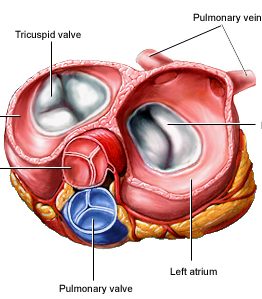
|
|
Pacemaker implantation
A pacemaker is a medical device that uses electrical impulses, delivered by electrodes contacting the heart muscles, to regulate the beating of the heart. The primary purpose of a pacemaker is to maintain an adequate heart rate. Modern pacemakers are externally programmable and allow the cardiologist to select the optimum pacing modes for individual patients.
A pacemaker is typically inserted into the patient through a simple surgery. In most cases the pacemaker is inserted in the left shoulder area where an incision is made below the collar bone creating a small pocket where the pacemaker is actually housed in the patient's body.
Pacemaker patients have ID cards that carry information of patients.
The Hungarian cardiac hospitals each install about 300 pacemakers each year as a routine treatment.
|
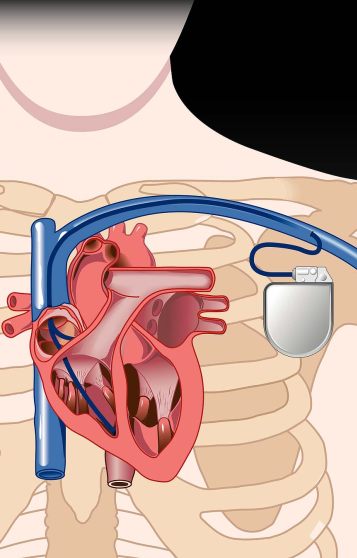 |
|
Cardioverter defibrillator implantation ( ICD )
An implantable cardioverter-defibrillator ( ICD ) is a small battery-powered electrical impulse generator that is implanted in patients who are at risk of sudden cardiac death due to ventricular fibrillation and ventricular tachycardia. The device is programmed to detect cardiac arrhythmia and correct it by delivering a jolt of electricity.
Similar to pacemakers, these devices typically include electrode wire(s) that pass through a vein to the right chambers of the heart, usually lodging in the apex of the right ventricle. The difference is that pacemakers are more often temporary and are generally designed to correct bradycardia, while ICDs are often permanent safeguards against sudden arrhythmias.
People who have an implanted cardioverter-defibrillator can live full lives. Usually the ICD improves the living conditions of a patient significantly. As with a pacemaker, however, living with an ICD does impose some restrictions on the person's lifestyle.
Implantable cardioverter defibrillators have demonstrated clear life-saving benefits.
The Hungarian cardiac hospitals each implant about 200 defibrillators each year as a routine treatment.
|
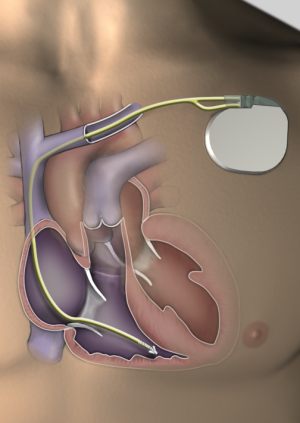 |
|
Ablation
This treatment aims to try to control your abnormal heart rhythm.
The process may take a few hours: thin, flexible tubes called catheters are placed into one of your veins or arteries, usually in your groin. The catheters are gently moved into the correct position in your heart.
Radiofrequency energy is then used to destroy the affected area inside your heart that is. The process helps to block the abnormal electrical impulses in this part of your heart causing the abnormal heart rhythm.
The process may take a few hours: thin, flexible tubes called catheters are placed into one of your veins or arteries, usually in your groin. The catheters are gently moved into the correct position in your heart.
Radiofrequency energy is then used to destroy ( ablate ) the affected area inside your heart that is causing the abnormal heart rhythm.
The Hungarian cardiac hospitals each implant about 200 defibrillators each year as a routine treatment.
|
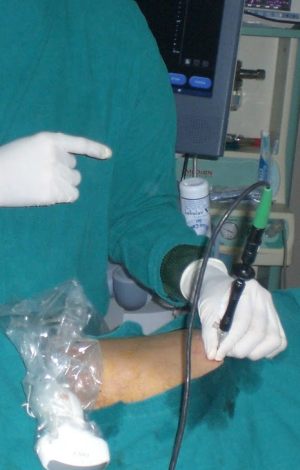
|
Our cardiac hospital in SZEGED
|
The city is a medical centre: many hospitals in one place.
The cardiac clinic is one of the most prestigious medical establishment in Hungary, with about 1,000 cardiac surgeries a year. The clinic is situated on the bank of river Tisza. They perform all surgeries mentioned above.
The rehabilitation section is located outside Szeged ( an 8 mins drive from the clinic ): it is a fully equipped ex-castle with clean air and spacious garden, the best option for cardiac patients to heal. It has 50 beds; there are VIP rooms for foreigner patients: the rooms can accomodate 1-2 family members too ( upon request ). The length of rehabilitation is at least 1 week: 2 weeks after operation the stiches are removed during extra rehabilitation ( highly recommended ).
|
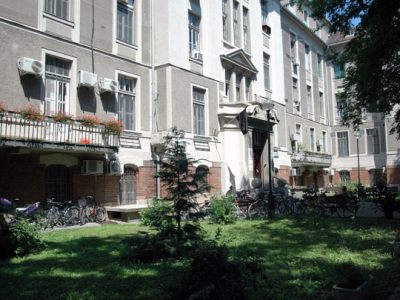 |
By-pass surgeries are done ( 99% ) with 'beating heart' tecnique ( risk factor 1% ), this is the only clinic in Hungary with this high rate. This is also the only clinic where adults and also small babies can be operated with cardiac deseases.
They have the most extensive experience in human valves in Hungary.
Their 2012 data: 933 cardiac surgeries ( with 577 by-pass surgeries ).
A walk-in rehabilitation is also available, upon request ( with hotel stay in Szeged ).
Approx. 2 weeks additional rehabilitation ( with stich removal ) is highly recommended, for the maximum result.
Safety is also very important: there is a full video surveillance in the house, for maximum safety.
Our cardiac hospital in BALATONFURED
|
The hospital is the biggest cardiac rehabilitation centre in Hungary: it has 427 beds and up-to-date facility appliances.
It is suitable to evaluate the actual state of different cardiovascular diseases.
Another advantage is the town's excellent microclimate: the Lake Balaton is located on one side ( the hospital is built on the shore of the lake ) and a big forest surrounded by nice hills on the other; the winter is mild, the spring comes early and the autumn lasts longer. The air is very clean in this area.
These factors cause a curative effect on cardiac patients.
Special fields: rehabilitation, angioplasty, pacemaker installation
|
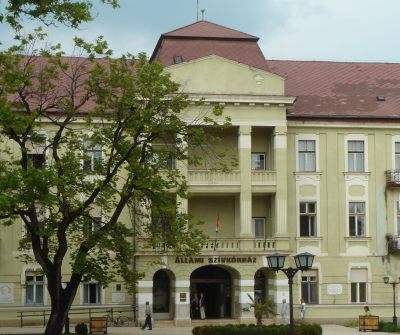 |
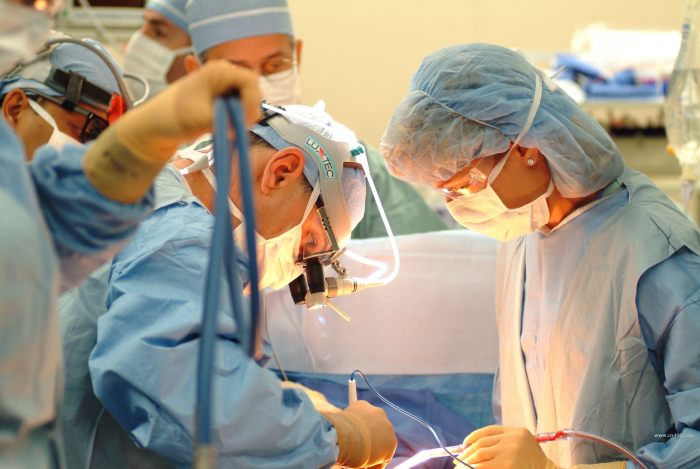
"The joy of health and beauty… and the World smiles with You"

















